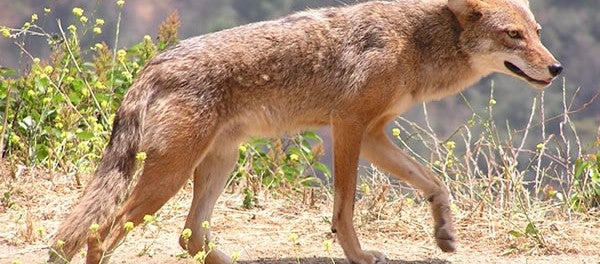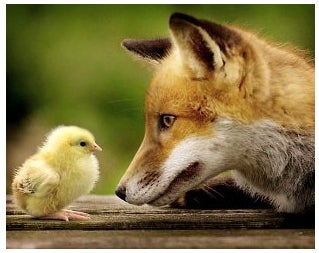The Top 10 Predators on the Farm

One of the more unpleasant aspects of farming is dealing with predators on the farm. Whether they come by ground or sky, the one constant is that they can to serious damage to animal population as well as destroying property and crops. It can be difficult to prevent predation, but a key element in doing so is to know what type of predator on your farm. Different predators have different behavioral patterns as well as times that they are most likely to strike and being aware of such things is one step in the affront against them. Below is a list of the top 10 predators you are most likely to find on the farm.
1. A common aerial predator is the hawk, which watches from afar before striking and is not always seen until it’s too late. Hawks attempt to scoop up prey but sometimes those animals are dropped to the ground with severe injuries. However, there are times when a hawk will attack and consume the head and neck in the same location. Do keep in mind that despite the many problems you may have with hawks, it is illegal to kill birds of prey.
2. Another aerial predator is the owl, which also watches from afar before making a move. Just like a hawk, the owl grabs prey with its talons with the goal of carrying it off, although sometimes badly injured prey does escape. Consumption at ground level takes place in the head and neck area in the case of owls as well as hawks.
3. Opossums are messy hunters that tend to go after prey at night. Although they go for easy prey, they are opportunistic and will also go after animals that are ill or weak. Opossums tend to make a meal out of their kill right on the spot, often starting in the abdominal area. If you run across an opossum, it may play dead but it also may turn and face you with a mouth full of teeth. Be careful with these animals as they are known to spread diseases, such as EPM in horses, so they especially need to be prevented from accessing animal feed.
4. Raccoons will eat practically anything which makes them a like a garbage disposal. They will get into trash, kill other animals, and destroy crops, all of which is easily done with their opposable thumbs. A raccoon kill is often pulled apart in pieces. Raccoons are also known to kill in excess of what they can consume.
5. When foxes go on the attack, they don’t seem to know when to stop. Once the carnage begins, it often becomes frenzied, with the fox continuing to kill until there is nothing left to kill. As the victims of a fox attack panic, this seems further encourage foxes to a point of pursing all animals within reach, regardless of hunger. If you find a coop full of dead chickens, for example, a fox could be to blame.
6. The Weasel family is comprised of many members (skunk, mink, badger, ferret, etc.), all of which kill multiple animals and consume from the abdomen. Kills are usually made with multiple small bites to the neck and head and evidence of attack is usually left behind because although a weasel can enter through small spaces, it can rarely drag its prey away through those same spaces. Another sign of a weasel attack is that they leave their kills stacked up neatly in piles.
7. Hunting at night and often in packs, coyotes are a threat to several animals found on the farm. They often work to isolate and take down a member of a heard and are known to dig into contained areas such as chicken coops. When a coyote has struck, there is often little evidence. Due to them carrying their kill away to consume it, it typically appears as though an animal has simply vanished. If you do find a dead animal, however, a good sign of a coyote attack is bite marks on the head and neck as coyotes go for the jugular vein.
8. Bobcats lay in wait, hunting undercover until the opportunity to kill arises, at which point they attack with sharp claws and large incisors. Bite and scratch marks will be found on the neck, shoulders, and back of prey and consumption tends to begin in this area as well. Though bobcats hunt both during the day and night, they do most of their hunting at night and carry prey away. Partially consumed animals are occasionally found a few hundred yards away buried for concealment and a possible return to feed again later.
9. Although they sometimes sleep in bed with us and are tasked with being guardians, it is not impossible for a dog to naturally have a high prey drive. In order to control such impulses, it is important that dogs be trained thoroughly and that training be reinforced regularly. It also may be necessary to contain dogs that struggle with the urge to pursue farm animals as prey. Even if your dog is well fed, that doesn’t guarantee good behavior as some dogs kill for sport. It is possible, too, that your neighbor’s dog could be a threat to your livestock, and the danger does not only exist in small animals that dogs could kill; dogs known to give chase can and have run larger livestock animals through fences, causing fatal injury without ever issuing a single bite.
10. Dogs aren’t the only pet you may have to worry about preying on your farm animals, as cats have been known to do so as well. Cats are able to kill animals that are their size or even larger which makes them a threat to rabbits, chickens, and the like. Although cats prove invaluable when it comes to pest control, it is imperative that cats are killing actual pests as opposed to other productive farm animals. Training cats is a tough job, so be sure to select cats that have good temperaments and do not focus their energy on animals you wish to keep around.
Depending on where you live, you may be faced with more predators than these 10. Mountain lions, wolves, panthers, bears, feral pigs, alligators, and snakes are also threats with which you may be faced. The larger the predator, the larger the prey they can take down, up to and including human beings. If predators are a problem on your farm, it may be necessary to protect yourself as well as your animals so that you are able to ward off potential attacks. You should be sure to check local and federal laws regarding the killing of predatory animals, however, as in some cases it is illegal.
When it comes to predation on the farm, the best defense is a strong offense. Contain animals in secure enclosures, use electric netting for fencing, secure trash in animal-proof containers, store feed out of reach of animals, and hang nets to prevent attacks from the sky. The less accessible and appetizing your farm is, the more likely predators are to find other sources of food, which truly is best for all involved.







 Your Privacy Choices
Your Privacy Choices
The number 1 predictor could possibly be radical animal welfare/rights groups.
This is a very nice article. I would add that all animals, including us, like to get the most food for the least amount of work. Its simple mathematics. If you expend more calories to get your food than you receive from it, its a path to starvation. This applies to the predator situation because if we make it harder to get at our animals, their feed, and young, then the predator will go elsewhere for its meal. Its like thieves; every 5 minutes you delay them, 50% will move on to an easier target. (my numbers may be off, don’t quote me!) At my Urban Farm, we use 1/2 inch hardware cloth to enclose our chicken pens and “tractors”. We also make sure whenever we move the tractor, the edges are not above any holes where a critter could reach through (or worse, crawl through), all doors have raccoon-resistant latches, and we are alert to any strange noises at night. We still have losses, but I’m sure it would be much worse without the precautions.
I have a sow pig she had a litter of nine for the past 4 days I have had 1 baby pig come up missing with no trace. until last night another baby pig came up missing, but also has a grow duck that was attacked and badly injured that we had to put down. Do you have any idea what could be happenning.